By Carlo Platella
The presentation of the SF-24 marks a breaking point in the lineage of ground-effect Ferraris. From the first glance, the 2024 Rossa presents itself with different shapes, just as the design objectives are different. The ongoing correction of the disappointing 2023 machine, in fact, was limited by a basic architecture that left little room for maneuver. Hence the decision to start again from a different approach, with the aim of supporting the new design priorities for 2024. In light of this, the words of the technical director Enrico Cardile, when he was still commenting on the SF-23 last August, become the best presentation letter for Ferrari 2024: “We realized that some choices we made were wrong and they influenced our development a lot. For this reason, next year's car will not be an evolution, as happened in 2023, but will be entirely new.”
The goals for 2024
The 2023 Rossa suffered from aerodynamic instability problems, with excessive sensitivity to wind and yaw angles (the crossing of the car when cornering), conditions in which the surface is exposed to external turbulence from the wheels. The SF-23 denoted a continuous unpredictability which, in addition to taking away the pilots' confidence, deprived the team of references for development. The result was a general lack of performance, especially in racing configuration, which limited long-distance pace. Furthermore, to keep up with their rivals, the drivers were forced to push more than necessary, stressing the tires and accelerating their degradation.
2023 was used to study the origin of these problems, identified essentially in the aerodynamic characteristics. The updates introduced during the year, of which the Barcelona bottom-belly package stands out, had the aim of improving performance not through an increase in load or aerodynamic efficiency, but by working on predictability and ease of driving. In general, the objective was to provide better aerodynamic characteristics with which to find performance, so as to be able to soften the driving in the race and manage the tires better.
However, the correction work in 2023 was limited by the impossibility of distorting the design of the bellies, above all due to the layout of the internal components and the chassis structures. The same goes for the suspensions, which are crucial on current Formula 1 cars as they stabilize the floor at a constant height from the ground in various driving conditions. From all this comes a Ferrari 2024 revolutionized compared to the previous one, whose renewed shapes are functional to the new aerodynamic objectives. “It's about finding the right architectures to achieve the objectives”Cardile's premise from last August.
Chassis
The SF-24 can be defined as a revolution, as it was born around a different concept compared to the past, not limited to the shape of the sides, but understood as the way the car works and overall aerodynamic management. At the same time the new Rossa can be interpreted as an evolution, in that development work continues undertaken during the past season, but limited by pre-existing architecture. For this reason, the SF-24 was born around one “completely new platform”by the same definition as Enrico Cardile, with the remaking of the chassis.
The bellies play a fundamental role in protecting and enhancing the bottom, but their design is conditioned by the arrangement of the internal components and the frame. This is why the 2024 bodyshell presents the anti-intrusion cone to protect the passenger compartment integrated directly into the bottom (1). This frees up space in the lower part of the side, allowing it to be flared and clearing it of the protuberance present in 2023 precisely in correspondence with the safety structure.
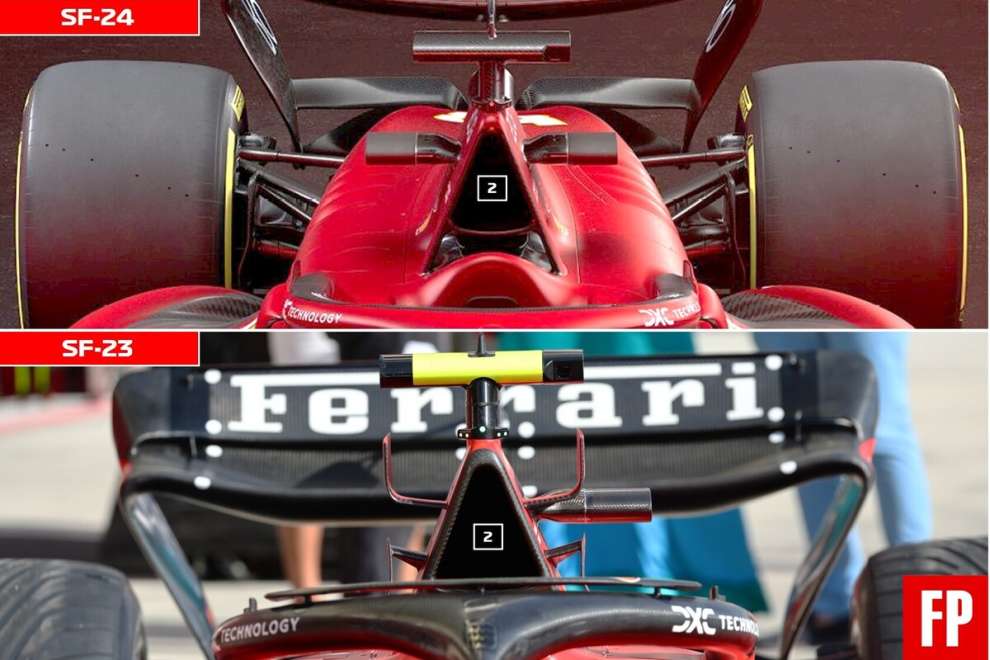
Another important clue to the guiding thought of the SF-24 lies in the dynamic air intake located at the pilot's head. Ferrari it is the only one to continue with a single main opening for the engine, without auxiliary air intakes for cooling (2). It is a symptom of the strong decentralization of the radiators in the bellies, lowering the center of gravity and streamlining the bonnet, while the competition opts for a partial centralization of the masses at the head of the engine, with the aim of flaring the bodywork. For its part, Ferrari has worked hard to reposition and improve the packaging of the electronic components, another limiting factor during the 2023 development.
Beaten bellies
The bodywork completes the transformation undertaken last year with the Barcelona package. The relocation of the protection cones and the different packaging under the bonnet allow the Cavallino to embrace the flat-bellied layout, now dominant on the grid. The sides descend towards the rear (3), conveying the flows adhering to the surfaces in the gearbox area, injecting useful energy to encourage the work of the speaker. The flare in the front-lower part of the belly is more pronounced than in 2023, channeling energy transport flows along the lower contour of the bodywork. However, the undercut, the channel created under the sides, is shallower than the competition.
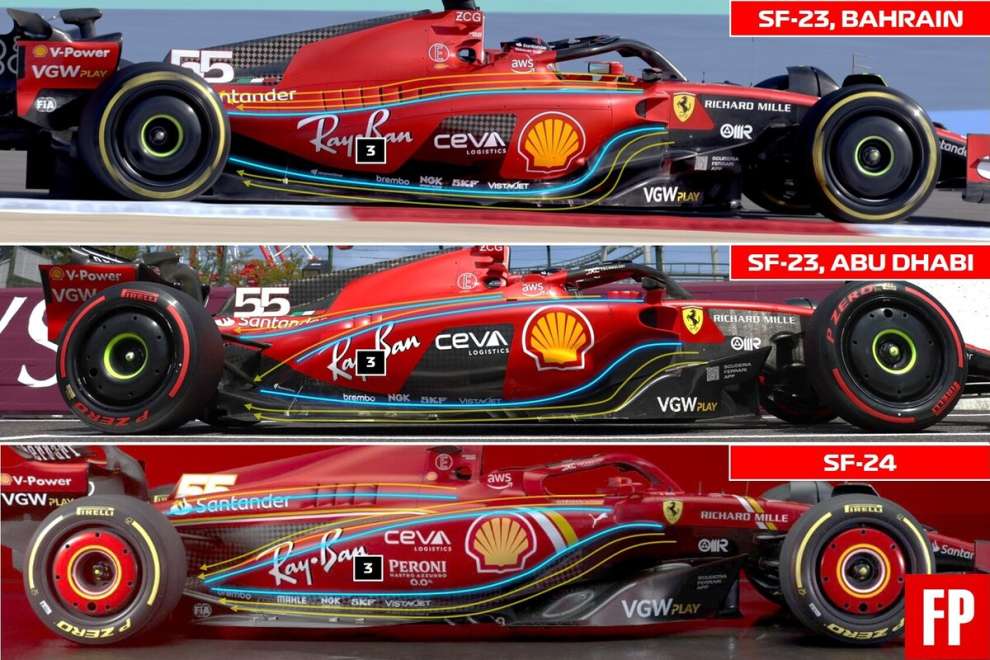
The rear view highlights the new geometries of the bodywork, with a larger surface descending towards the gearbox. The upper part of the bellies is also slightly hollowed out, with a hint of the channels that teams like McLaren, Aston Martin and Alpine present in a decidedly more marked manner (4). Drawing inspiration from the competition, Ferrari also created the “tray” solution for the upper part of the bonnet, with a high and wide geometry to separate the hot air evacuated from the engine compartment from the aerodynamics of the bellies.
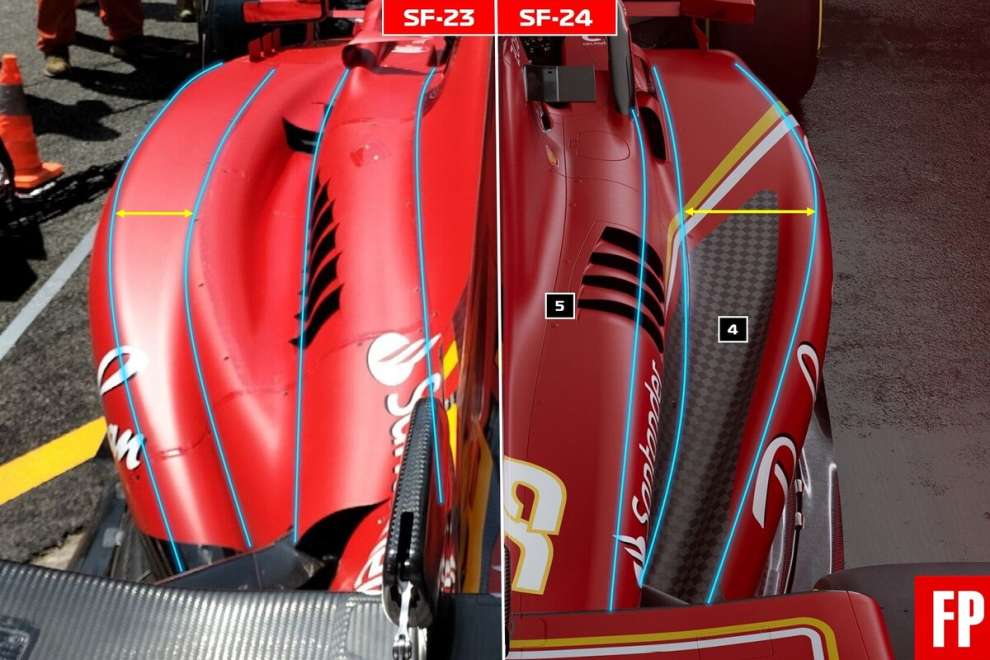
New vents
Another important change concerns the side air intakes. Ferrari abandons the oval outline of the SF-23, moving closer to the geometries of the Red Bull school (6). Contrary to other teams, the Cavallino does not excessively squeeze the mouths upwards, a theoretically useful solution for channeling a greater flow of air under the belly. This is a channel useful for increasing local pressure, which can be used as a shield to protect the car against external turbulence.

There lateral pressurization of the passenger compartment, however, is a question of compromise between two contributions, the second of which is associated with the lower speed and therefore greater pressure of the air entering the vents. For this reason, in Maranello it was not considered advantageous to thin the lateral intakes beyond a certain limit. What has changed above all is the extension of the lower lip of the mouth, which, like on most rival cars, now extends towards the front (7). Once again, the modification serves to channel air under the bodywork towards the rear and increase local pressure.
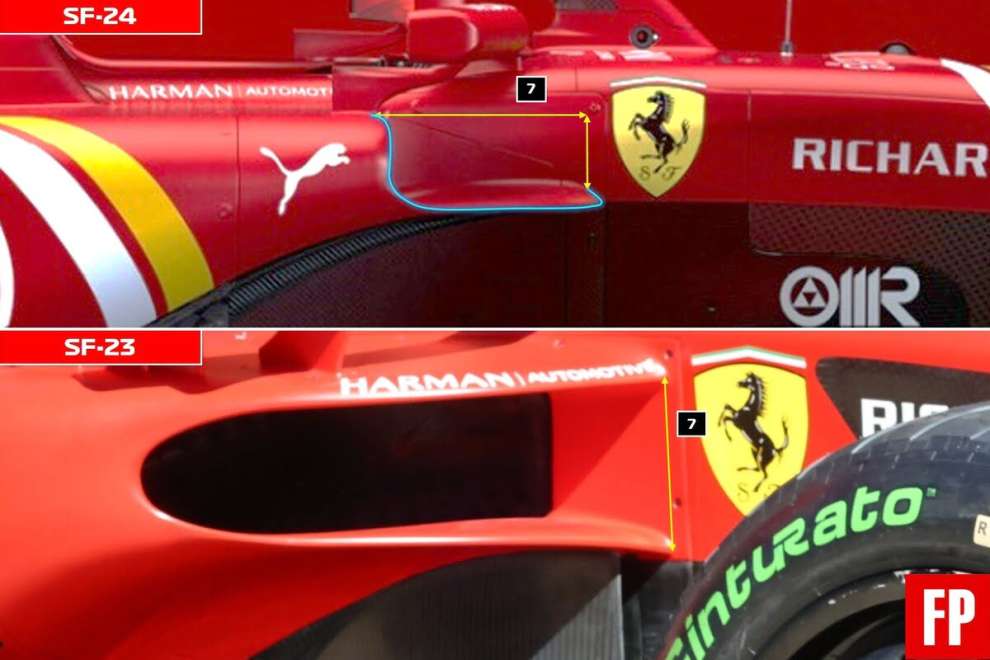
Suspensions
The suspensions constitute a key area for achieving the objectives of aerodynamic stability and driving predictability, being called upon to stabilize the surface at constant heights from the ground and postures. Ferrari has optimized the kinematics and in general the internal mechanics of the spring-shock absorber groups, changes which however are not appreciable from the outside. What is visible instead is the confirmation of the push-rod scheme at the frontpreferred to the pull-rod which Red Bull, McLaren, Sauber and Racing Bulls consider aerodynamically advantageous.
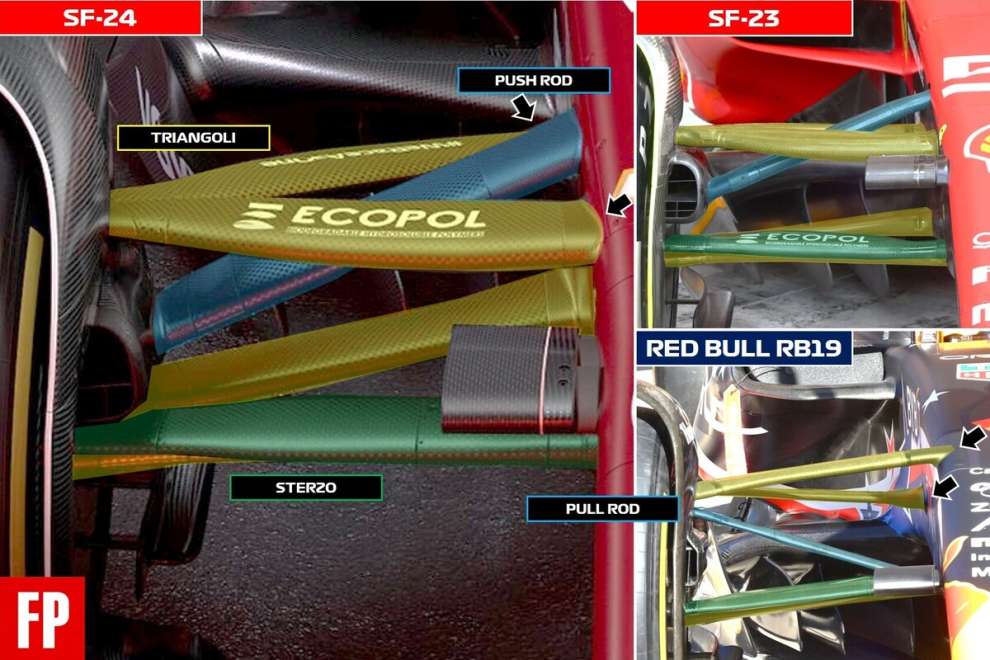
Compared to the SF-23, the height difference between the front and rear arms of the upper triangle (8) increases. Ferrari is also looking for a major anti-pitching kinematics, useful for stabilizing the rotations of the car and therefore of the surface during braking, ensuring greater consistency in the generation of aerodynamic load. The impression is that the SF-24 presents a lower degree of anti-pitch than those seen on cars such as Red Bull and Aston Martin, indicating a different compromise with the management of local flows and with the sensations transmitted to the driver through the steering wheel .
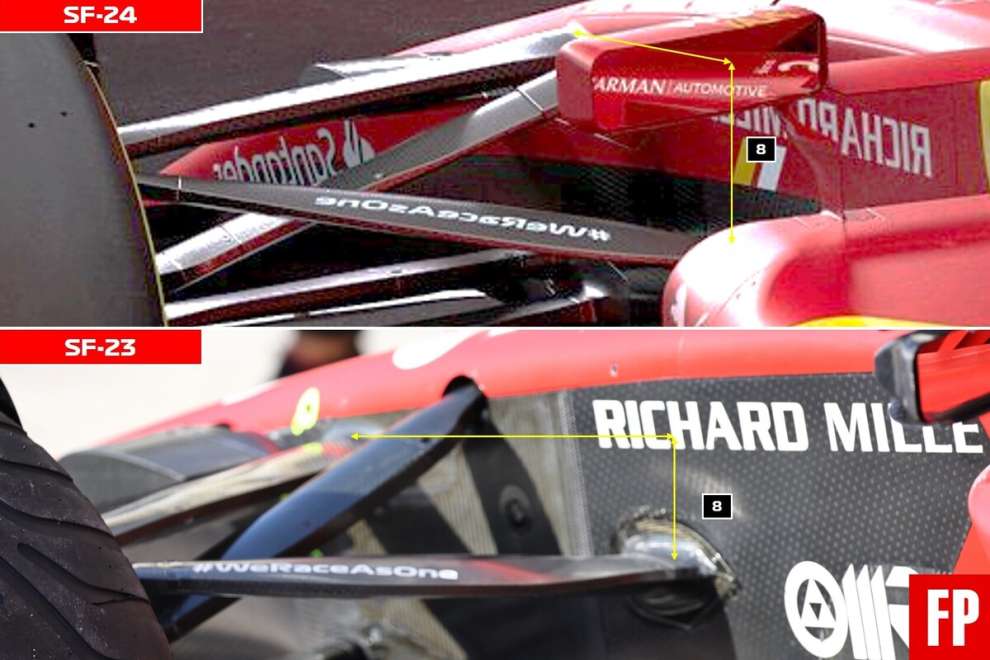
Contrary to predictions, the pull-rod suspension is confirmed at the rear, although the inclination of the rod and arms has been revised. Ferrari and Haas are now the only teams to prefer the tie-rod scheme compared to the strut one, which instead frees up space in the lower part of the gearbox in correspondence with the flows collected by the sides, housing the mechanics above the transmission.
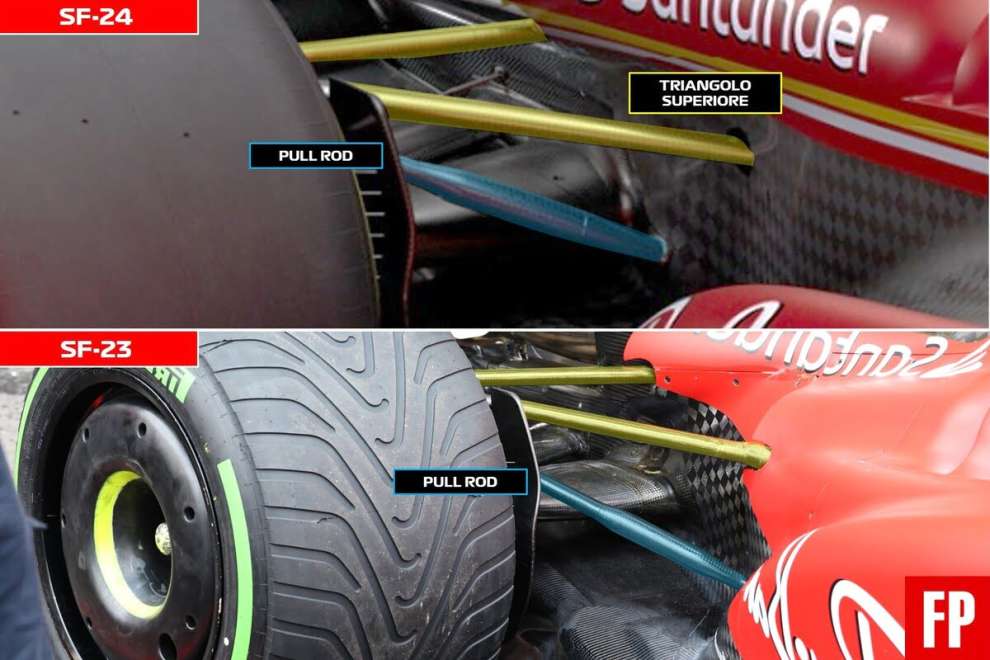
Aerodynamics
As always, digital presentations prevent us from expressing any consideration on the aerodynamic details, in particular on the external edge of the bottom and on the shape of the Venturi channels, the most important areas for ground effect Formula 1 cars. The absence of a frontal image also prevents us from commenting on the configuration of the front wing, on which we can still glimpse a more rounded nose (9), with the addition of two bridge supports between the first and penultimate element.
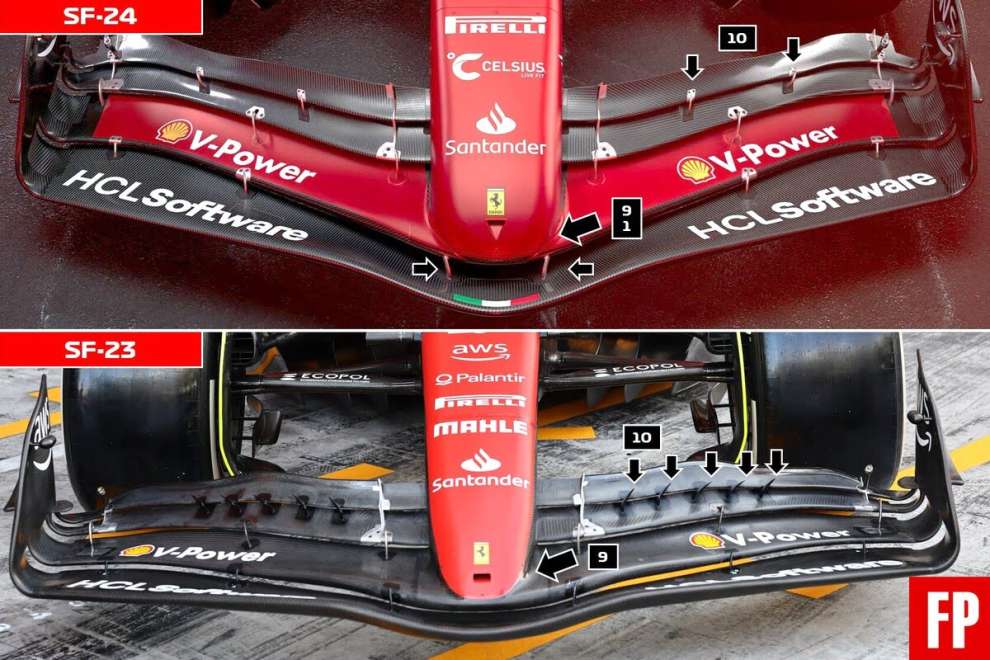
Also absent on the front wing, at least in the presentation phase, are the five flow diverters of the SF-23 (10), also structured as vortex generators. At the center of the car, the numerous appendages on the sides of the anti-tipping structure also temporarily disappear (11). On the other hand, new profiles (12) appear on the sides of the rear halo supports, which outline a blowing immediately behind the S-Duct vent, confirmed from 2023.
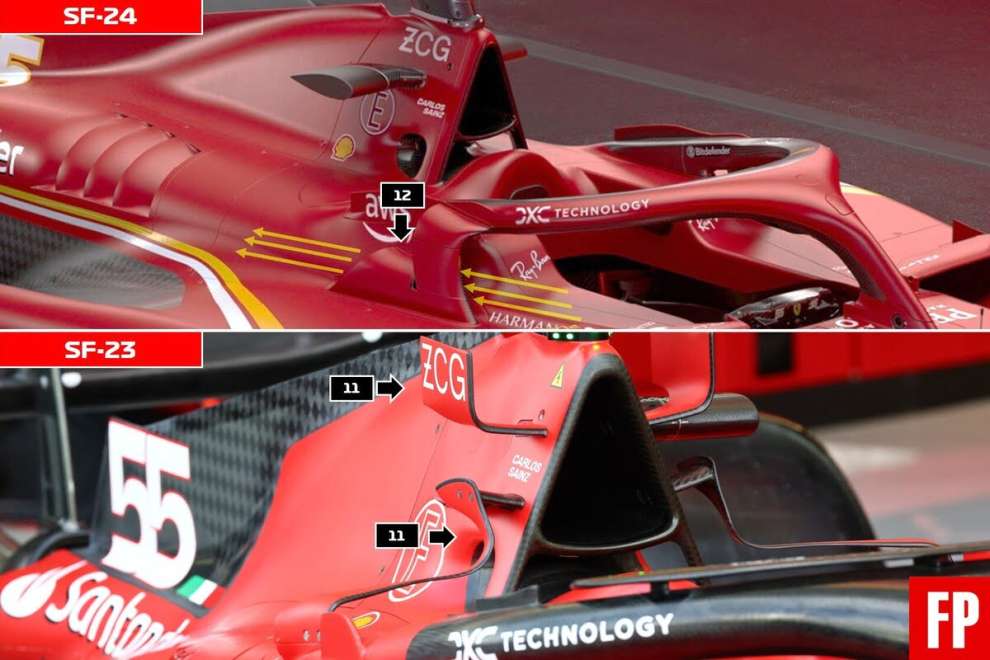
Inspiration, without copying
The SF-24 assimilates many of the concepts inspired by Red Bull and now dominant on the grid, such as the side impact structures integrated into the bottom, the slide bellies, the high and flattened bonnet or the side air intakes with the elongated lip. On the other hand, in some respects Ferrari does not present the extreme geometries seen on rival cars, such as the extreme flattening of the radiator openings, the marked level of anti-pitch at the front, the depth of the excavation along the lower part of the bodywork or the rejection of the push-rod scheme for the rear suspension. It is difficult to establish whether, in the considerations certainly carried out in Maranello, the same potential was not glimpsed in some concepts, sometimes not appreciable until developed, or whether it is considered more profitable not to take some choices to the extreme, preferring compromise geometries so as not to sacrifice excessively expectant. As always, the track will give its verdict.
#technical #analysis #Ferrari #SF24 #revolution #clear #objectives